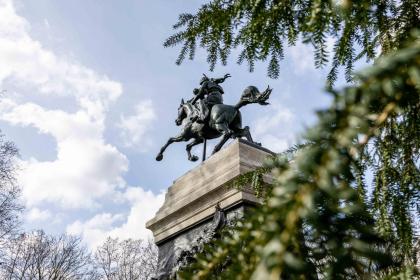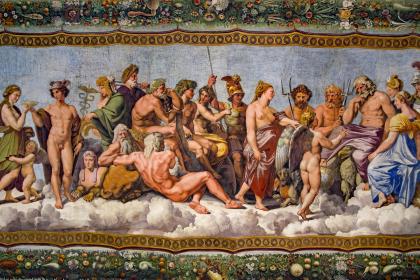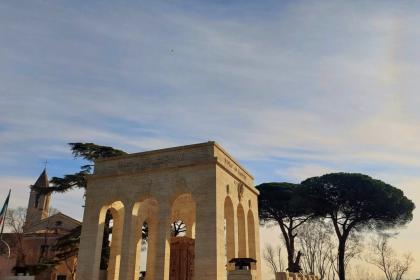For more than a hundred years, Giuseppe Garibaldi has good-naturedly watched over Rome atop the Janiculum Hill, from which he deservedly enjoys one of the most impressive views of the city for whose freedom he fought so strenuously.
The birth of a symbol of freedom
In 1883, one year after his death at Caprera on 2 June 1882, Parliament decided to dedicate a monument to him to celebrate his libertarian impetus and courageous battles. On 14 November, therefore, a contest was announced that would lead to the choice of a project for a sculptural work consisting of a majestic plinth crowned by a bronze statue of Garibaldi portrayed standing or on horseback to be placed in the garden of San Pietro in Montorio. Among the 37 sketches exhibited in the newly inaugurated Palazzo delle Esposizioni, the judging commission, made up of Monteverde, Boito, Rosa and Morelli, some members of Parliament, and the then Prime Minister, Agostino Depretis, won that of Emilio Gallori. The only request made to the artist was to make the sculptures that would have delimited the four sides of the monument more lively and dynamic, as they were considered too static and cold. In 1885, Gallori presented the new project and the proposal to place the monument on the top of Trastevere's hill, the summit of the new promenade and the most suitable place to host the simulacrum of the Italian leader and patriot's mighty personality. The site was granted on 15 May 1892 and the foundation stone was laid on 19 March 1895 in the presence of the royal family.
The monument to Giuseppe Garibaldi was unveiled with great pomp on 20 September 1895, on the occasion of the celebrations for the 25th anniversary of the liberation of Rome, in the presence of Umberto I and Margherita di Savoia, the Prime Minister, Francesco Crispi, the Mayor of the Italian Capital, Emanuele Ruspoli, as well as some Garibaldi veterans and about 60,000 people.
A bronze and granite tribute to greatness
Serene, riding his horse, the Hero of Two Worlds wears the iconic Magyar cap and the American poncho adopted in the Montevideo wars, and stands on a large Baveno granite pedestal on the base of which are carved the She-wolf of Rome, the Lion of Caprera and a frieze with weapons in use in ancient Rome, as well as four bas-reliefs – the Landing at Marsala, the Resistance at Boiada, the Defence of Rome in 1849 and Liberty – surmounted by four bronze sculptural groups depicting on the long sides, the allegories of Europe (with History and Genius) and America (with Industry and Trade); on the short sides, Luciano Manara's bersaglieri defending Rome in the Battle of 1849 and the 1860 Calatafimi fighters. On the left side of the pedestal is the famous phrase ROMA O MORTE (Rome or Death), uttered by Garibaldi during his speech at the gathering of the Red Shirts in Marsala on 19 July 1862.
Curiosities
Among the sketches, the one by Ximenes-Guidini saw the hero rising on a pyramid. It was rejected.
The monument was restored by the Sovrintendenza Capitolina in 1990 and maintained in 2011, for the 150th anniversary of the Unification of Italy. It was therefore in good condition until the night between 6 and 7 September 2018 when the bas-relief depicting the Lion of Caprera was suddenly struck by lightning, sustaining very serious damage. The work had suffered two other similar incidents – in September 1944 and July 1963 – probably due to its dominant position. After the last occurrence, the monument was restored again in 2022 with the installation of a lightning rod based on the Faraday cage theory.
Photo: Turismo Roma
Il monumento ad Anita Garibaldi al Gianicolo

 Condividi
Condividi
Rione XIII - Trastevere

Mausoleo Ossario Garibaldino

 Condividi
Condividi
Information
 Condividi
Condividi
Locations
To find out about all accessibility services, visit the Rome accessible section.











































